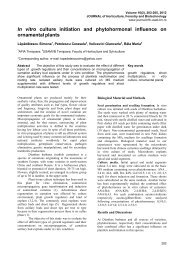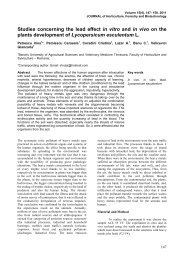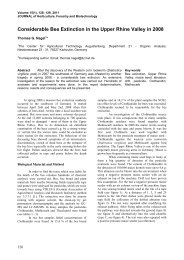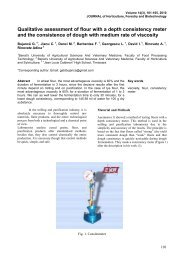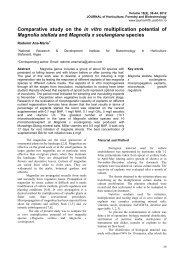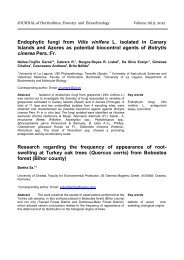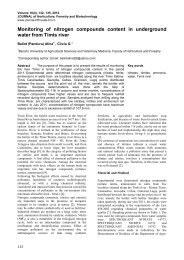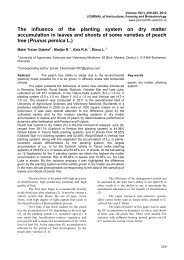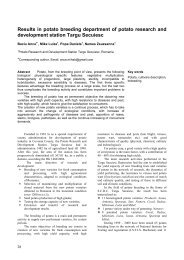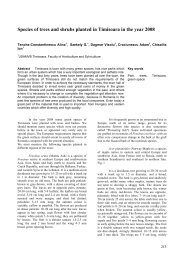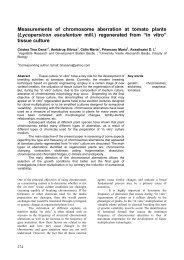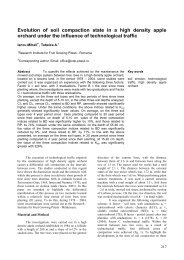Results in Ficus australis rooting on different substrata and with ...
Results in Ficus australis rooting on different substrata and with ...
Results in Ficus australis rooting on different substrata and with ...
Create successful ePaper yourself
Turn your PDF publications into a flip-book with our unique Google optimized e-Paper software.
Volume 16(4), 105- 109, 2012<br />
JOURNAL of Horticulture, Forestry <strong>and</strong> Biotechnology<br />
www.journal-hfb.usab-tm.ro<br />
<str<strong>on</strong>g>Results</str<strong>on</strong>g> <str<strong>on</strong>g>in</str<strong>on</strong>g> <str<strong>on</strong>g>Ficus</str<strong>on</strong>g> <str<strong>on</strong>g>australis</str<strong>on</strong>g> root<str<strong>on</strong>g>in</str<strong>on</strong>g>g <strong>on</strong> <strong>different</strong> <strong>substrata</strong> <strong>and</strong><br />
<strong>with</strong> <strong>different</strong> root<str<strong>on</strong>g>in</str<strong>on</strong>g>g enhancers <strong>with</strong> effect <strong>on</strong> cutt<str<strong>on</strong>g>in</str<strong>on</strong>g>g root<str<strong>on</strong>g>in</str<strong>on</strong>g>g<br />
<str<strong>on</strong>g>in</str<strong>on</strong>g> the fall<br />
Anches C. 1 *, Bala Maria 1<br />
Banat’s University of Agricultural Sciences <strong>and</strong> Veter<str<strong>on</strong>g>in</str<strong>on</strong>g>ary Medic<str<strong>on</strong>g>in</str<strong>on</strong>g>e Timişoara, Faculty of Horticulture <strong>and</strong><br />
Forestry<br />
*Corresp<strong>on</strong>d<str<strong>on</strong>g>in</str<strong>on</strong>g>g author. Email: codrut.anches@iuliusmall.com<br />
Abstract <str<strong>on</strong>g>Ficus</str<strong>on</strong>g> is an ornamental plant that, due to its presence, can add<br />
life <strong>and</strong> beauty to a flat room. So far, they know more than 800 species of<br />
ficus of the tree, shrub or climb<str<strong>on</strong>g>in</str<strong>on</strong>g>g plant type (Bala Maria, Floricultura<br />
generala si speciala, 2007). A ficus can be described as a vigorous, woody<br />
plant <strong>with</strong> large, sk<str<strong>on</strong>g>in</str<strong>on</strong>g>ny, ellipse-shaped, dark green to yellowish leaves. The<br />
genus <str<strong>on</strong>g>Ficus</str<strong>on</strong>g> c<strong>on</strong>ta<str<strong>on</strong>g>in</str<strong>on</strong>g>s plants that are extremely varied from trees over 30 m<br />
tall <str<strong>on</strong>g>in</str<strong>on</strong>g> their countries of orig<str<strong>on</strong>g>in</str<strong>on</strong>g> to dwarf, creep<str<strong>on</strong>g>in</str<strong>on</strong>g>g species. Some of these<br />
species are largely used <str<strong>on</strong>g>in</str<strong>on</strong>g> manufactur<str<strong>on</strong>g>in</str<strong>on</strong>g>g medic<str<strong>on</strong>g>in</str<strong>on</strong>g>es.<br />
<str<strong>on</strong>g>Ficus</str<strong>on</strong>g> Australis is a plant <strong>with</strong> difficult root<str<strong>on</strong>g>in</str<strong>on</strong>g>g: this is why we have used four<br />
types of root<str<strong>on</strong>g>in</str<strong>on</strong>g>g <strong>substrata</strong> <strong>and</strong> three root<str<strong>on</strong>g>in</str<strong>on</strong>g>g stimulators. The trial was carried<br />
out <str<strong>on</strong>g>in</str<strong>on</strong>g> the greenhouses of the Faculty of Horticulture of the Banat University of<br />
Agricultural Science <strong>and</strong> Veter<str<strong>on</strong>g>in</str<strong>on</strong>g>ary Medic<str<strong>on</strong>g>in</str<strong>on</strong>g>e of Timisoara (Romania) where<br />
climate factors supply good c<strong>on</strong>diti<strong>on</strong>s for the root<str<strong>on</strong>g>in</str<strong>on</strong>g>g of this plant.<br />
As a result of the trial, we came to the c<strong>on</strong>clusi<strong>on</strong> that the greenhouses <str<strong>on</strong>g>in</str<strong>on</strong>g><br />
which we carried out the trial provide good c<strong>on</strong>diti<strong>on</strong>s for plant growth <strong>and</strong><br />
development over <strong>on</strong>e or several years (Bala Maria, Floricultura Generala-<br />
Curs, 1998).<br />
<str<strong>on</strong>g>Results</str<strong>on</strong>g> show that the culture substratum has <strong>different</strong> effects <strong>on</strong> plant root<str<strong>on</strong>g>in</str<strong>on</strong>g>g<br />
<strong>and</strong> development from the biostimulators used <str<strong>on</strong>g>in</str<strong>on</strong>g> the trial.<br />
Key words<br />
ficus,<br />
substratum,<br />
stimulator, root<str<strong>on</strong>g>in</str<strong>on</strong>g>g<br />
<str<strong>on</strong>g>Ficus</str<strong>on</strong>g> is an evergreen, tree-like woody plant, <strong>with</strong><br />
extremely decorative leaves due to their shape, size,<br />
<strong>and</strong> colour.<br />
<str<strong>on</strong>g>Ficus</str<strong>on</strong>g> is a shrub <strong>with</strong> slower growth but <strong>with</strong> many<br />
branches. Its stem is elastic, slightly woody, <strong>and</strong> very<br />
branchy.<br />
<str<strong>on</strong>g>Ficus</str<strong>on</strong>g> bel<strong>on</strong>gs to the Family Moraceae <strong>and</strong> it<br />
orig<str<strong>on</strong>g>in</str<strong>on</strong>g>ates <str<strong>on</strong>g>in</str<strong>on</strong>g> the tropical areas of Asia, Africa, <strong>and</strong><br />
Australia. There are several types of ficus: tree-like,<br />
shrubby, or climb<str<strong>on</strong>g>in</str<strong>on</strong>g>g. The leaves are oval, sk<str<strong>on</strong>g>in</str<strong>on</strong>g>ny,<br />
dark-green, <strong>and</strong> sh<str<strong>on</strong>g>in</str<strong>on</strong>g>y. No matter the species or<br />
cultivar, ficus is a slow-grow<str<strong>on</strong>g>in</str<strong>on</strong>g>g plant, particularly<br />
dur<str<strong>on</strong>g>in</str<strong>on</strong>g>g w<str<strong>on</strong>g>in</str<strong>on</strong>g>ter. Because of its low branch<str<strong>on</strong>g>in</str<strong>on</strong>g>g ability,<br />
ficus needs more cutt<str<strong>on</strong>g>in</str<strong>on</strong>g>g to <str<strong>on</strong>g>in</str<strong>on</strong>g>crease its decorat<str<strong>on</strong>g>in</str<strong>on</strong>g>g<br />
effect. The better the ficus is cared for, the larger <strong>and</strong><br />
nicer it is (Van Wyk, p. 1972. Copacii d<str<strong>on</strong>g>in</str<strong>on</strong>g> Parcul<br />
Nați<strong>on</strong>al Kruger)<br />
Let's positi<strong>on</strong> the plants where they can enjoy a good<br />
source of light, yet avoid<str<strong>on</strong>g>in</str<strong>on</strong>g>g direct sunsh<str<strong>on</strong>g>in</str<strong>on</strong>g>e, which<br />
could cause antiaesthetic burn<str<strong>on</strong>g>in</str<strong>on</strong>g>gs <strong>on</strong> the foliage.<br />
These plants d<strong>on</strong>'t agree <strong>with</strong> cold temperatures dur<str<strong>on</strong>g>in</str<strong>on</strong>g>g<br />
this time of year. They can be grown outside. The<br />
<str<strong>on</strong>g>Ficus</str<strong>on</strong>g> <str<strong>on</strong>g>australis</str<strong>on</strong>g> should be grown <str<strong>on</strong>g>in</str<strong>on</strong>g> a bright place, <strong>with</strong><br />
direct sunlight.<br />
There are several species of ficus <strong>with</strong> <strong>different</strong> low<br />
temperature tolerance levels, <str<strong>on</strong>g>in</str<strong>on</strong>g>clud<str<strong>on</strong>g>in</str<strong>on</strong>g>g <str<strong>on</strong>g>Ficus</str<strong>on</strong>g> <str<strong>on</strong>g>australis</str<strong>on</strong>g><br />
which is more resistant to cold compared to other<br />
species <strong>and</strong> also adapted to maritime climate.<br />
The number of rooted cutt<str<strong>on</strong>g>in</str<strong>on</strong>g>gs as well as their growth<br />
is <str<strong>on</strong>g>in</str<strong>on</strong>g>fluenced by greenhouse c<strong>on</strong>diti<strong>on</strong>s, by root<str<strong>on</strong>g>in</str<strong>on</strong>g>g<br />
substratum, <strong>and</strong> by root<str<strong>on</strong>g>in</str<strong>on</strong>g>g biostimulators.<br />
<str<strong>on</strong>g>Ficus</str<strong>on</strong>g> root<str<strong>on</strong>g>in</str<strong>on</strong>g>g <strong>and</strong> development depend <strong>on</strong> the quality<br />
of chemical <strong>and</strong> physical <strong>and</strong> cultivati<strong>on</strong> substratum, as<br />
well as <strong>on</strong> the amount of assailable nutrients <str<strong>on</strong>g>in</str<strong>on</strong>g> the<br />
culture substratum (Militiu Amelia, Floricultura, 1965).<br />
Most ficus grow <strong>and</strong> develop well <str<strong>on</strong>g>in</str<strong>on</strong>g> aerated, humusrich<br />
culture <strong>substrata</strong>, but there are also ficus that<br />
require a heavier or a lighter substratum.<br />
Material <strong>and</strong> Methods<br />
In this trial, we aimed at obta<str<strong>on</strong>g>in</str<strong>on</strong>g><str<strong>on</strong>g>in</str<strong>on</strong>g>g a larger number of<br />
ficus rooted cutt<str<strong>on</strong>g>in</str<strong>on</strong>g>gs <strong>and</strong>, therefore, healthy, vigorous<br />
plants.<br />
The trials were carried out <str<strong>on</strong>g>in</str<strong>on</strong>g> the greenhouses of the<br />
Faculty of Horticulture <strong>and</strong> Forestry of the BUASVM<br />
Timisoara, where climate factors provide good<br />
105
c<strong>on</strong>diti<strong>on</strong>s for the root<str<strong>on</strong>g>in</str<strong>on</strong>g>g <strong>and</strong> development of the<br />
species <str<strong>on</strong>g>Ficus</str<strong>on</strong>g>.<br />
The trial was carried out <strong>on</strong> three species of <str<strong>on</strong>g>Ficus</str<strong>on</strong>g>, i.e.<br />
<str<strong>on</strong>g>Ficus</str<strong>on</strong>g> elastica, <str<strong>on</strong>g>Ficus</str<strong>on</strong>g> Benjam<str<strong>on</strong>g>in</str<strong>on</strong>g>a, <str<strong>on</strong>g>Ficus</str<strong>on</strong>g> <str<strong>on</strong>g>australis</str<strong>on</strong>g>. In<br />
this paper, we refer <strong>on</strong>ly to the root<str<strong>on</strong>g>in</str<strong>on</strong>g>g of <str<strong>on</strong>g>Ficus</str<strong>on</strong>g><br />
Australis, s<str<strong>on</strong>g>in</str<strong>on</strong>g>ce <str<strong>on</strong>g>in</str<strong>on</strong>g> this species the number of rooted<br />
cutt<str<strong>on</strong>g>in</str<strong>on</strong>g>gs is smaller than <str<strong>on</strong>g>in</str<strong>on</strong>g> other species.<br />
In order to establish the best root<str<strong>on</strong>g>in</str<strong>on</strong>g>g <strong>substrata</strong>, the trial<br />
was carried out <str<strong>on</strong>g>in</str<strong>on</strong>g> 4 variants: s<strong>and</strong>, perlite, peat +<br />
perlite, <strong>and</strong> peat + perlite + s<strong>and</strong>.<br />
Ant<strong>on</strong> Do<str<strong>on</strong>g>in</str<strong>on</strong>g>a (Floricultura Generala, 2003) shows that,<br />
to make a ficus root, we can use special <strong>substrata</strong><br />
produced by well-established companies; <strong>on</strong>e of these<br />
<strong>substrata</strong> is THP25 produced by Turberies de France,<br />
whose chemical compositi<strong>on</strong> is 60% black peat, 35%<br />
bl<strong>on</strong>d peat, 5% soil <strong>with</strong> 15-20% clay.<br />
Accord<str<strong>on</strong>g>in</str<strong>on</strong>g>g to Lazureanu Aurel (Agrotehnica, 1994),<br />
fertility is that property of the culture substratum of<br />
supply<str<strong>on</strong>g>in</str<strong>on</strong>g>g the cutt<str<strong>on</strong>g>in</str<strong>on</strong>g>gs <strong>with</strong> smaller or larger amounts<br />
of nutrients <str<strong>on</strong>g>in</str<strong>on</strong>g> proper air <strong>and</strong> water c<strong>on</strong>diti<strong>on</strong>s.<br />
Each experimental variant had several replicas <strong>with</strong> 20<br />
cutt<str<strong>on</strong>g>in</str<strong>on</strong>g>gs each, the c<strong>on</strong>trol be<str<strong>on</strong>g>in</str<strong>on</strong>g>g represented the average<br />
of the trial. Previously to putt<str<strong>on</strong>g>in</str<strong>on</strong>g>g the cutt<str<strong>on</strong>g>in</str<strong>on</strong>g>gs to root,<br />
we treated them <strong>with</strong> root<str<strong>on</strong>g>in</str<strong>on</strong>g>g stimulators us<str<strong>on</strong>g>in</str<strong>on</strong>g>g<br />
Radistim, Revita, <strong>and</strong> At<strong>on</strong>ik.<br />
To <str<strong>on</strong>g>in</str<strong>on</strong>g>terpret the results, we used variance analysis. The<br />
variants were set after the r<strong>and</strong>omised block method<br />
<strong>with</strong> 3 replicas specific to trials <str<strong>on</strong>g>in</str<strong>on</strong>g> forced, protected<br />
flower cultivati<strong>on</strong> areas (Ciulca Sor<str<strong>on</strong>g>in</str<strong>on</strong>g>, Tehnica<br />
experimentala, Ed Mirt<strong>on</strong> Timisoara, 2002).<br />
The stimulators used to make the ficus cutt<str<strong>on</strong>g>in</str<strong>on</strong>g>gs root<br />
were at<strong>on</strong>ik, radistim, <strong>and</strong> revital.<br />
Davidescu D <strong>and</strong> Davidescu Velicica (Agrochimie<br />
horticola, 1992) recommend apply<str<strong>on</strong>g>in</str<strong>on</strong>g>g root<str<strong>on</strong>g>in</str<strong>on</strong>g>g N P K<br />
(2:1:1)-based biostimulators 0.5-0.7% 24 hours after<br />
harvest<str<strong>on</strong>g>in</str<strong>on</strong>g>g from the mother-plant.<br />
Penn<str<strong>on</strong>g>in</str<strong>on</strong>g>gsfeld F. cited by S<strong>on</strong>ea V. (Floricultura<br />
generala, 1971) recommend the periodical analysis of<br />
the root<str<strong>on</strong>g>in</str<strong>on</strong>g>g substratum to avoid nutriti<strong>on</strong> unbalance<br />
caused by high rates of fertilisers; the same author<br />
groups <str<strong>on</strong>g>Ficus</str<strong>on</strong>g> am<strong>on</strong>g the plants <strong>with</strong> high tolerance to<br />
soil sal<str<strong>on</strong>g>in</str<strong>on</strong>g>ity.<br />
<str<strong>on</strong>g>Results</str<strong>on</strong>g> <strong>and</strong> Discussi<strong>on</strong>s<br />
Table 1<br />
Analysis of variance c<strong>on</strong>cern<str<strong>on</strong>g>in</str<strong>on</strong>g>g the substratum <strong>and</strong> root<str<strong>on</strong>g>in</str<strong>on</strong>g>g stimulator <strong>on</strong> <str<strong>on</strong>g>Ficus</str<strong>on</strong>g> <str<strong>on</strong>g>australis</str<strong>on</strong>g> cutt<str<strong>on</strong>g>in</str<strong>on</strong>g>gs root<str<strong>on</strong>g>in</str<strong>on</strong>g>g<br />
Source of variati<strong>on</strong> SP GL S 2 Test F<br />
Total 4,136.98<br />
Replicas 16.67 2 8.33 F=0.23<br />
Substratum 2,493.23 3 831.08 F= 23.37**<br />
Stimulator 364.06 3 121.35 F= 3.41*<br />
Substratum x Stimulator 196.35 9 21.82 F= 0.61<br />
Error 1,066.67 30 35.56<br />
Tak<str<strong>on</strong>g>in</str<strong>on</strong>g>g <str<strong>on</strong>g>in</str<strong>on</strong>g>to account the results of the variance analysis<br />
(Table 1), we see that both studied factors had<br />
c<strong>on</strong>siderable, statistically ensured impact <strong>on</strong> the<br />
root<str<strong>on</strong>g>in</str<strong>on</strong>g>g of <str<strong>on</strong>g>Ficus</str<strong>on</strong>g> <str<strong>on</strong>g>australis</str<strong>on</strong>g> cutt<str<strong>on</strong>g>in</str<strong>on</strong>g>gs <strong>with</strong> little impact of<br />
envir<strong>on</strong>mental c<strong>on</strong>diti<strong>on</strong>s <strong>on</strong> the results.<br />
Effect of root<str<strong>on</strong>g>in</str<strong>on</strong>g>g substratum <strong>on</strong> <str<strong>on</strong>g>Ficus</str<strong>on</strong>g> <str<strong>on</strong>g>australis</str<strong>on</strong>g> cutt<str<strong>on</strong>g>in</str<strong>on</strong>g>gs root<str<strong>on</strong>g>in</str<strong>on</strong>g>g<br />
Root<str<strong>on</strong>g>in</str<strong>on</strong>g>g substratum Averages (%) Relative values (%)<br />
Difference/<br />
Significance<br />
Perlite - S<strong>and</strong> 61.25 52.92 115.74 8.33**<br />
(Perlite+Peat) - S<strong>and</strong> 70.83 52.92 133.84 17.91***<br />
(Perlite+Peat+S<strong>and</strong>) - S<strong>and</strong> 69.58 52.92 131.48 16.66***<br />
(Perlite+Peat) - Perlite 70.83 61.25 115.64 9.58***<br />
(Perlite+Peat+S<strong>and</strong>) - Perlite 69.58 61.25 113.60 8.33**<br />
(Perlite+Peat+S<strong>and</strong>) - (Perlite+Peat) 69.58 70.83 98.24 -1.25<br />
DL 5% =4.97 DL 1% =6.89 DL 0.1% =8.87<br />
Table 2<br />
As for the effect of the substratum <strong>on</strong> the root<str<strong>on</strong>g>in</str<strong>on</strong>g>g rate<br />
of ficus cutt<str<strong>on</strong>g>in</str<strong>on</strong>g>gs (Table 2), we can see a medium<br />
variability (13.07%) <strong>and</strong> a span of 17.91% between the<br />
values corresp<strong>on</strong>d<str<strong>on</strong>g>in</str<strong>on</strong>g>g to the four root<str<strong>on</strong>g>in</str<strong>on</strong>g>g <strong>substrata</strong>, <strong>with</strong><br />
limits between 52.92% <strong>on</strong> s<strong>and</strong> <strong>and</strong> 70.83% <strong>on</strong> perlite<br />
+ peat.<br />
The most complex mixture (s<strong>and</strong> + perlite +<br />
peat) had the same high efficacy <strong>on</strong> ficus cutt<str<strong>on</strong>g>in</str<strong>on</strong>g>gs<br />
root<str<strong>on</strong>g>in</str<strong>on</strong>g>g result<str<strong>on</strong>g>in</str<strong>on</strong>g>g <str<strong>on</strong>g>in</str<strong>on</strong>g> significant <str<strong>on</strong>g>in</str<strong>on</strong>g>creases of 16.66-<br />
8.33% more compared to results <strong>on</strong> s<strong>and</strong> + perlite. The<br />
lowest efficacy <strong>on</strong> cutt<str<strong>on</strong>g>in</str<strong>on</strong>g>gs root<str<strong>on</strong>g>in</str<strong>on</strong>g>g – significantly<br />
<str<strong>on</strong>g>in</str<strong>on</strong>g>ferior to that of the other variants – was <strong>on</strong> s<strong>and</strong>.<br />
106
Effect of root<str<strong>on</strong>g>in</str<strong>on</strong>g>g stimulators <strong>on</strong> <str<strong>on</strong>g>Ficus</str<strong>on</strong>g> <str<strong>on</strong>g>australis</str<strong>on</strong>g> cutt<str<strong>on</strong>g>in</str<strong>on</strong>g>gs root<str<strong>on</strong>g>in</str<strong>on</strong>g>g<br />
Root<str<strong>on</strong>g>in</str<strong>on</strong>g>g stimulator Averages (%) Relative values (%) Difference/Significance<br />
Radistim - C<strong>on</strong>trol 67.50 60.83 110.96 6.67*<br />
Revital - C<strong>on</strong>trol 65.00 60.83 106.86 4.17<br />
At<strong>on</strong>ik - C<strong>on</strong>trol 61.25 60.83 100.69 0.42<br />
Revital - Radistim 65.00 67.50 96.30 -2.50<br />
At<strong>on</strong>ik - Radistim 61.25 67.50 90.74 -6.25 0<br />
At<strong>on</strong>ik - Revital 61.25 65.00 94.23 -3.75<br />
DL 5% =4.97 DL 1% =6.89 DL 0.1% =8.87<br />
Table 3<br />
Tak<str<strong>on</strong>g>in</str<strong>on</strong>g>g <str<strong>on</strong>g>in</str<strong>on</strong>g>to account the unilateral effect of cultivati<strong>on</strong><br />
durati<strong>on</strong>, Table 3 shows that cell biomass had a low<br />
variability of 5% associated to a span of 6.67% <strong>with</strong><br />
values between 60.83% <str<strong>on</strong>g>in</str<strong>on</strong>g> the treated variant <strong>and</strong><br />
67.50% <str<strong>on</strong>g>in</str<strong>on</strong>g> the variant treated <strong>with</strong> Radistim. This<br />
variability shows that there are smaller differences<br />
generally not ensured statistically between the <strong>different</strong><br />
stimulators. As such, the treatment <strong>with</strong> Radistim had a<br />
significant effect <strong>on</strong> the cutt<str<strong>on</strong>g>in</str<strong>on</strong>g>gs root<str<strong>on</strong>g>in</str<strong>on</strong>g>g, result<str<strong>on</strong>g>in</str<strong>on</strong>g>g <str<strong>on</strong>g>in</str<strong>on</strong>g><br />
<str<strong>on</strong>g>in</str<strong>on</strong>g>creases of 6.25-6.67%, compared to the variant not<br />
treated <strong>and</strong> compared to the variant treated <strong>with</strong><br />
At<strong>on</strong>ik. Apply<str<strong>on</strong>g>in</str<strong>on</strong>g>g Revital allowed an <str<strong>on</strong>g>in</str<strong>on</strong>g>crease of about<br />
7% of cutt<str<strong>on</strong>g>in</str<strong>on</strong>g>g root<str<strong>on</strong>g>in</str<strong>on</strong>g>g, but this value is not statistically<br />
ensured. Treatment <strong>with</strong> At<strong>on</strong>ik had an extremely low,<br />
<str<strong>on</strong>g>in</str<strong>on</strong>g>significant effect <strong>on</strong> cutt<str<strong>on</strong>g>in</str<strong>on</strong>g>g root<str<strong>on</strong>g>in</str<strong>on</strong>g>g.<br />
Table 4<br />
Effect of substratum <strong>and</strong> root<str<strong>on</strong>g>in</str<strong>on</strong>g>g stimulator <strong>on</strong> <str<strong>on</strong>g>Ficus</str<strong>on</strong>g> <str<strong>on</strong>g>australis</str<strong>on</strong>g> cutt<str<strong>on</strong>g>in</str<strong>on</strong>g>gs root<str<strong>on</strong>g>in</str<strong>on</strong>g>g<br />
Stimulator Substratum<br />
S<strong>and</strong> Perlite Perlite+Peat Perlite+Peat+S<strong>and</strong> x s<br />
x S %<br />
C<strong>on</strong>trol z50.00a yz56.67a x71.67a xy65.00b 60.83+3.25 18.50<br />
Radistim y56.67a y61.67a x75.00a x76.67a 67.50+2.85 14.65<br />
Revital y55.00a x65.00a x70.00a x70.00ab 65.00+2.22 11.83<br />
At<strong>on</strong>ik y50.00a x61.67a x66.67a x66.67b 61.25+2.23 12.61<br />
x s<br />
x 52.92+1.68 61.25+1.25 70.83+2.02 69.58+1.89 63.65+1.35<br />
S % 11.00 7.07 9.91 9.80 14.74<br />
DL 5% =9.94 DL 1% =13.39 DL 0.1% =17.75<br />
Can be c<strong>on</strong>sidered significant the differences between<br />
the comb<str<strong>on</strong>g>in</str<strong>on</strong>g>ati<strong>on</strong>s marked a, b, c for vertical<br />
comparis<strong>on</strong>s <strong>and</strong> x, y, z for horiz<strong>on</strong>tal comparis<strong>on</strong>s.<br />
On the substratum based <strong>on</strong> perlite, the cutt<str<strong>on</strong>g>in</str<strong>on</strong>g>gs<br />
resulted <str<strong>on</strong>g>in</str<strong>on</strong>g> an <str<strong>on</strong>g>in</str<strong>on</strong>g>crease of the root<str<strong>on</strong>g>in</str<strong>on</strong>g>g percentage of<br />
8.33% associated <strong>with</strong> a low variability of 7.07%, <strong>with</strong><br />
a limit of 56.67% <str<strong>on</strong>g>in</str<strong>on</strong>g> the variant not-treated <strong>and</strong> 65.00%<br />
<str<strong>on</strong>g>in</str<strong>on</strong>g> the variant treated <strong>with</strong> Revital. Thus, <strong>on</strong> the<br />
substratum <strong>with</strong> root<str<strong>on</strong>g>in</str<strong>on</strong>g>g biostimulators, there was an<br />
<str<strong>on</strong>g>in</str<strong>on</strong>g>crease of the cutt<str<strong>on</strong>g>in</str<strong>on</strong>g>g root<str<strong>on</strong>g>in</str<strong>on</strong>g>g percentage, but the<br />
<str<strong>on</strong>g>in</str<strong>on</strong>g>creases were not statistically ensured.<br />
On the mixture of perlite + peat, the cutt<str<strong>on</strong>g>in</str<strong>on</strong>g>g root<str<strong>on</strong>g>in</str<strong>on</strong>g>g<br />
percentage had a low variability close to the other two<br />
<strong>substrata</strong> (9.91%) for a span of 8.33%, <strong>with</strong> limits of<br />
66.67% when treated <strong>with</strong> At<strong>on</strong>ik <strong>and</strong> 75.00% when<br />
treated <strong>with</strong> Radistim. Tak<str<strong>on</strong>g>in</str<strong>on</strong>g>g <str<strong>on</strong>g>in</str<strong>on</strong>g>to account the low<br />
differences between the values related to the <strong>different</strong><br />
treatments <strong>and</strong> the fact that <strong>on</strong>ly the treatment <strong>with</strong><br />
Radistim allowed a root<str<strong>on</strong>g>in</str<strong>on</strong>g>g percentage superior to that<br />
of the c<strong>on</strong>trol, we can say that the root<str<strong>on</strong>g>in</str<strong>on</strong>g>g stimulators<br />
used <strong>on</strong> this substratum had a very low, <str<strong>on</strong>g>in</str<strong>on</strong>g>significant<br />
effect <strong>on</strong> cutt<str<strong>on</strong>g>in</str<strong>on</strong>g>g root<str<strong>on</strong>g>in</str<strong>on</strong>g>g.<br />
107
Cutt<str<strong>on</strong>g>in</str<strong>on</strong>g>gs root<str<strong>on</strong>g>in</str<strong>on</strong>g>g (%)<br />
Inradac<str<strong>on</strong>g>in</str<strong>on</strong>g>are butasi (%)<br />
80<br />
76,67<br />
75,00<br />
70<br />
71,67<br />
70,00<br />
65,00<br />
65,00<br />
66,67<br />
60<br />
61,67<br />
61,67<br />
56,67<br />
56,67<br />
55,00<br />
50<br />
DL5%<br />
50,00<br />
Nisip<br />
Perlit<br />
Perlit +Turbă<br />
Perlit+ Turbă+Nisip<br />
50,00<br />
40<br />
C<strong>on</strong>trol Radistim Revital At<strong>on</strong>ik<br />
Stimulator <str<strong>on</strong>g>in</str<strong>on</strong>g>radac<str<strong>on</strong>g>in</str<strong>on</strong>g>are<br />
Fig. 1. <str<strong>on</strong>g>Ficus</str<strong>on</strong>g> <str<strong>on</strong>g>australis</str<strong>on</strong>g> cutt<str<strong>on</strong>g>in</str<strong>on</strong>g>gs root<str<strong>on</strong>g>in</str<strong>on</strong>g>g under the impact of <strong>different</strong> <strong>substrata</strong> <strong>and</strong> biostimulators<br />
On the substratum of perlite + peat + s<strong>and</strong>, cutt<str<strong>on</strong>g>in</str<strong>on</strong>g>gs<br />
recorded a root<str<strong>on</strong>g>in</str<strong>on</strong>g>g percentage of 11.67% associated to<br />
a variability close to the average of the other <strong>substrata</strong><br />
(9.80%), <strong>with</strong> limits between 65.00% <str<strong>on</strong>g>in</str<strong>on</strong>g> the c<strong>on</strong>trol<br />
variant <strong>and</strong> 76.67% <str<strong>on</strong>g>in</str<strong>on</strong>g> the variant treated <strong>with</strong><br />
Radistim. On this substratum, the treatments <strong>with</strong><br />
biostimulators determ<str<strong>on</strong>g>in</str<strong>on</strong>g>ed an <str<strong>on</strong>g>in</str<strong>on</strong>g>crease of the<br />
percentage of cutt<str<strong>on</strong>g>in</str<strong>on</strong>g>gs root<str<strong>on</strong>g>in</str<strong>on</strong>g>g. From this po<str<strong>on</strong>g>in</str<strong>on</strong>g>t of view,<br />
the best results were after apply<str<strong>on</strong>g>in</str<strong>on</strong>g>g Radistim which<br />
allowed significant <str<strong>on</strong>g>in</str<strong>on</strong>g>creases of 10.00-11.67%<br />
compared to the c<strong>on</strong>trol variant or to the variant treated<br />
<strong>with</strong> At<strong>on</strong>ik.<br />
The treatment <strong>with</strong> Radistim allowed the best results <str<strong>on</strong>g>in</str<strong>on</strong>g><br />
cutt<str<strong>on</strong>g>in</str<strong>on</strong>g>gs root<str<strong>on</strong>g>in</str<strong>on</strong>g>g <strong>on</strong> complex <strong>substrata</strong>, i.e. <strong>on</strong> perlite +<br />
peat + s<strong>and</strong>, or perlite + peat, while more simple<br />
<strong>substrata</strong> such as s<strong>and</strong> or perlite al<strong>on</strong>e are less<br />
effective.<br />
Treatments <strong>with</strong> Revital <strong>and</strong> At<strong>on</strong>ik had a significant<br />
effect <strong>on</strong> cutt<str<strong>on</strong>g>in</str<strong>on</strong>g>g root<str<strong>on</strong>g>in</str<strong>on</strong>g>g <strong>on</strong> all <strong>substrata</strong>, except the<br />
treatment <strong>on</strong> s<strong>and</strong> al<strong>on</strong>e.<br />
80<br />
76,67<br />
75,00<br />
70<br />
71,67<br />
70,00<br />
65,00<br />
65,00<br />
66,67<br />
60<br />
61,67<br />
61,67<br />
56,67<br />
56,67<br />
55,00<br />
50<br />
LSD5%<br />
50,00<br />
S<strong>and</strong><br />
Perlite<br />
Perlite+Peat<br />
Perlite+ Peat+S<strong>and</strong><br />
50,00<br />
40<br />
C<strong>on</strong>trol Radistim Revital At<strong>on</strong>ik<br />
Root<str<strong>on</strong>g>in</str<strong>on</strong>g>g stimulator<br />
Fig. 2. Root<str<strong>on</strong>g>in</str<strong>on</strong>g>g of <str<strong>on</strong>g>Ficus</str<strong>on</strong>g> <str<strong>on</strong>g>australis</str<strong>on</strong>g> cutt<str<strong>on</strong>g>in</str<strong>on</strong>g>gs under the <str<strong>on</strong>g>in</str<strong>on</strong>g>fluence of <strong>different</strong> substrates <strong>and</strong> stimulators<br />
108
C<strong>on</strong>clusi<strong>on</strong>s<br />
- The substratum had a higher c<strong>on</strong>tributi<strong>on</strong> (81.65%)<br />
<strong>on</strong> root<str<strong>on</strong>g>in</str<strong>on</strong>g>g variability compared to the effect of growth<br />
stimulators (11.92%). The comb<str<strong>on</strong>g>in</str<strong>on</strong>g>ed effect of the<br />
substratum <strong>and</strong> root<str<strong>on</strong>g>in</str<strong>on</strong>g>g stimulators had a low <str<strong>on</strong>g>in</str<strong>on</strong>g>fluence,<br />
not ensured statistically (6.43%) <strong>on</strong> the variability of<br />
the root<str<strong>on</strong>g>in</str<strong>on</strong>g>g level of the focus cutt<str<strong>on</strong>g>in</str<strong>on</strong>g>gs (Table 1).<br />
- Us<str<strong>on</strong>g>in</str<strong>on</strong>g>g the mixture of perlite + peat allowed the best<br />
root<str<strong>on</strong>g>in</str<strong>on</strong>g>g results, statistically ensured, between 9.58%<br />
compared to the perlite <strong>and</strong> 17.91% compared to the<br />
s<strong>and</strong> (Table 2).<br />
- As far as the comb<str<strong>on</strong>g>in</str<strong>on</strong>g>ed effect of substratum <strong>and</strong><br />
stimulators <strong>on</strong> <str<strong>on</strong>g>Ficus</str<strong>on</strong>g> <str<strong>on</strong>g>australis</str<strong>on</strong>g> cutt<str<strong>on</strong>g>in</str<strong>on</strong>g>gs root<str<strong>on</strong>g>in</str<strong>on</strong>g>g is<br />
c<strong>on</strong>cerned, we can see that <strong>on</strong> the s<strong>and</strong> substratum this<br />
feature recorded a very low variati<strong>on</strong> span (6.67%) <strong>and</strong><br />
a low to medium variability (11.00%) associated <strong>with</strong><br />
<str<strong>on</strong>g>in</str<strong>on</strong>g>significant differences between the <strong>different</strong><br />
stimulators. As such, <strong>on</strong> this substratum, the<br />
stimulators we used had no significant impact <strong>on</strong><br />
cutt<str<strong>on</strong>g>in</str<strong>on</strong>g>gs root<str<strong>on</strong>g>in</str<strong>on</strong>g>g <str<strong>on</strong>g>in</str<strong>on</strong>g> this species.<br />
- Tak<str<strong>on</strong>g>in</str<strong>on</strong>g>g <str<strong>on</strong>g>in</str<strong>on</strong>g>to account the effect of the <strong>different</strong><br />
stimulators <strong>on</strong> cutt<str<strong>on</strong>g>in</str<strong>on</strong>g>gs root<str<strong>on</strong>g>in</str<strong>on</strong>g>g <strong>on</strong> the four <strong>substrata</strong>,<br />
we can see there are significant real differences<br />
between the <strong>substrata</strong> depend<str<strong>on</strong>g>in</str<strong>on</strong>g>g <strong>on</strong> the three<br />
stimulators. When no stimulator was applied, the<br />
mixture perlite + peat allowed a cutt<str<strong>on</strong>g>in</str<strong>on</strong>g>g root<str<strong>on</strong>g>in</str<strong>on</strong>g>g<br />
percentage significantly superior to that of the simple<br />
<strong>substrata</strong> – s<strong>and</strong> or perlite al<strong>on</strong>e. The complex mixture<br />
s<strong>and</strong> + peat + perlite assured the c<strong>on</strong>diti<strong>on</strong>s for a<br />
significantly higher percentage of root<str<strong>on</strong>g>in</str<strong>on</strong>g>g compared to<br />
the substratum based <strong>on</strong> s<strong>and</strong> al<strong>on</strong>e.<br />
Bibliography<br />
1.Ant<strong>on</strong> Do<str<strong>on</strong>g>in</str<strong>on</strong>g>a et al., Floricultura generala, Ed<br />
Universitaria Craiova, 2003.<br />
2.Bala Maria, Floricultura generala, Ed Mirt<strong>on</strong><br />
Timisoara, 2003.<br />
3.Bala Maria, Floricultura generala si speciala, Ed de<br />
Vest, Timisoara, 2007<br />
4.Ciulca Sor<str<strong>on</strong>g>in</str<strong>on</strong>g>, Tehnica experimentala, Ed Mirt<strong>on</strong><br />
Timisoara, 2002.<br />
5.Ciulca Sor<str<strong>on</strong>g>in</str<strong>on</strong>g>, Metodologii de experimentare <str<strong>on</strong>g>in</str<strong>on</strong>g><br />
agricultura si biologie, Ed Agropr<str<strong>on</strong>g>in</str<strong>on</strong>g>t Timisoara,<br />
2006.<br />
6.Davidescu D si Davidescu Velicica (Agrochimie<br />
horticola, 1992)<br />
7.Lazureanu Aurel, Agrotehnica, Ed Helic<strong>on</strong>,<br />
Timisoara, 1994.<br />
8.Militiu Ameia, Floricutura, Ed Agro-Silvica,1965<br />
9.Penn<str<strong>on</strong>g>in</str<strong>on</strong>g>gsfeld F. cited by S<strong>on</strong>ea V. (Floricultura<br />
generala, 1971<br />
10.Van Wyk, p. 1972. Copacii d<str<strong>on</strong>g>in</str<strong>on</strong>g> Parcul Nați<strong>on</strong>al<br />
Kruger. Purnell, Cape Town.<br />
109



